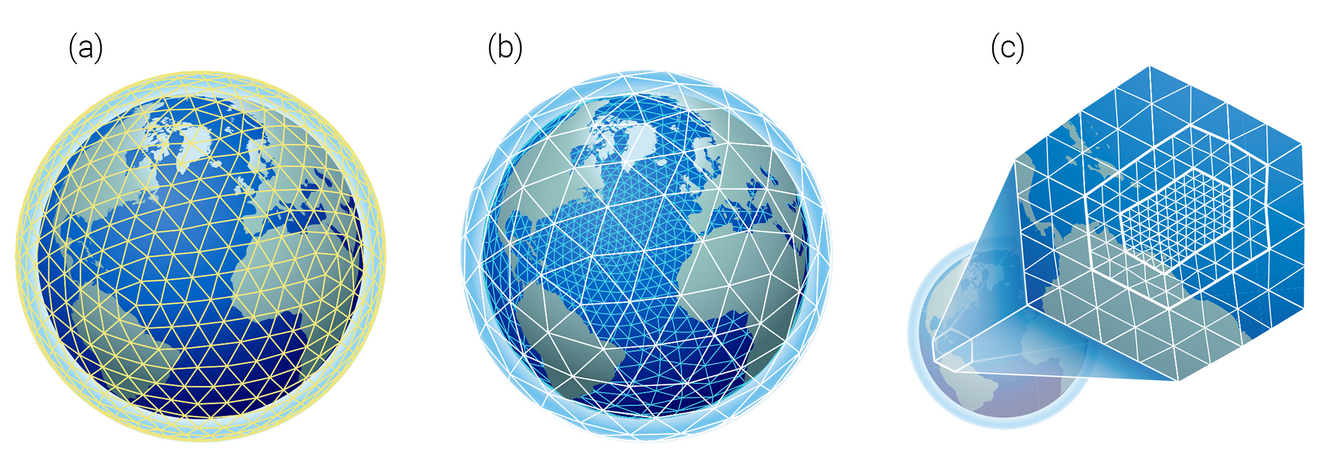The first release of ICON-Sapphire, targeting simulations of the Earth System at kilometer scale
ICON-Sapphire targets grid spacings of 10 km and finer. In the atmosphere, grid spacings of 10 km and finer allow resolving convective storms by solving the underlying fluid dynamical equations. This is of obvious importance given that the distribution of energy fuels the climate system and that convection is the main mechanism transporting energy vertically. In the ocean, grid spacings of 10 km and finer allow representing mesoscale eddies and marginally submesoscale eddies, changing the nature of the simulated ocean from a viscous to a turbulent flow and affecting the representation of the ocean circulation.
Through the selected simulation examples, the paper demonstrates that ICON-Sapphire can now be run with an atmosphere and ocean coupled, over the full Earth, on seasonal timescales with a grid spacing of 5 km, on monthly timescales with a grid spacing of 2.5 km, and on daily timescales with a grid spacing of 1.25 km. The throughput of the coupled 5 km simulation is 126 simulated days per day employing 21% of the latest machine of the German Climate Computing Center. Generally, a throughput of at least 100 simulated days per day is thought to be necessary for conducting simulations on climatic timescales. Moreover, ICON-Sapphire allows explicit simulations of large eddies in the atmosphere using hectometer grid spacings on limited-area domains in atmosphere-only simulations. It can also resolve the interactions between submesoscale eddies in the ocean and storms in the atmosphere on global domains by combining a uniform atmosphere with a 5-km grid spacing and a telescoping grid in the ocean with the finest grid spacing of 530 m. Finally, as a first step to demonstrate the Earth System Modeling abilities of ICON-Sapphire, which requires the simulation of carbon, results of a 4-year global ocean-only simulation including ocean biogeochemistry integrated on a grid spacing of 10 km are presented. Extrapolating from these results, multi-decadal global simulations including interactive carbon are now possible, and short global simulations resolving large eddies in the atmosphere and submesoscale eddies in the ocean are within reach.

Original publication
Hohenegger, C., Korn, P., Linardakis, L., Redler, R., Schnur, R., Adamidis, P., Bao, J., Bastin, S., Behravesh, M., Bergemann, M., Biercamp, J., Bockelmann, H., Brokopf, R., Brüggemann, N., Casaroli, L., Chegini, F., Datseris, G., Esch, M., George, G., Giorgetta, M., Gutjahr, O., Haak, H., Hanke, M., Ilyina, T., Jahns, T., Jungclaus, J., Kern, M., Klocke, D., Kluft, L., Kölling, T., Kornblueh, L., Kosukhin, S., Kroll, C., Lee, J., Mauritsen, T., Mehlmann, C., Mieslinger, T., Naumann, A. K., Paccini, L., Peinado, A., Praturi, D. S., Putrasahan, D., Rast, S., Riddick, T., Roeber, N., Schmidt, H., Schulzweida, U., Schütte, F., Segura, H., Shevchenko, R., Singh, V., Specht, M., Stephan, C. C., von Storch, J.-S., Vogel, R., Wengel, C., Winkler, M., Ziemen, F., Marotzke, J., and Stevens, B.: ICON-Sapphire: simulating the components of the Earth system and their interactions at kilometer and subkilometer scales, Geosci. Model Dev., 16, 779–811, https://gmd.copernicus.org/articles/16/779/2023/, 2023.
Contact
Dr. Cathy Hohenegger
Max Planck Institute for Meteorology
Email: cathy.hohenegger@mpimet.mpg.de
